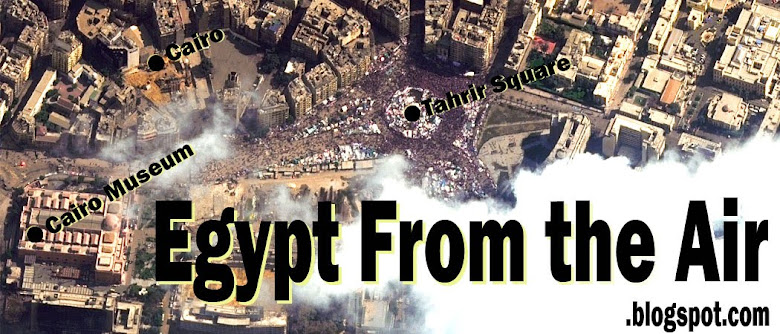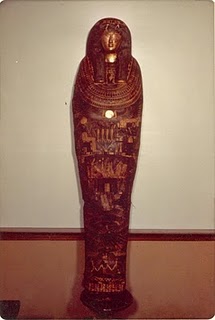Dr. Zahi Hawass is the current Secretary General of The Supreme Council of Antiquities in Egypt. He stepped down from this position because of his close ties to the Mubarak regime; however, he returned to the position less than a month later.
As a larger than life personality, he is never far from controversy.
Here he is in 2009 discussing his role in managing the tourist crowds, his relationship to the pyramids, and copy-righting the pyramids.
In 2007 he appeared on Al Jazeera to discuss Egypt's policy on stolen artifacts.
More recently, he was interviewed by CNN on the telephone describing what was looted and destroyed in the Cairo Museum during the protests.
As it turns out, Dr. Hawass now admits that looting and thievery is more widespread and more of a serious problem than he originally stated.
Dr. Hawass has posted on his blog a list of sites and antiquities that are in danger of being damaged.
Egypt from the Air is part of the Wings over the Pyramids: Will Egypt's Treasure Survive exhibit designed and curated by Museum Studies graduate students at San Francisco State University, under the guidance of Professor Linda Ellis.
This blog attempts to capture, document, and make accessible some of the hundreds of thousands of videos, articles and photographs relating to the dramatic events that have swept across Egypt since early 2011.
Wings over the Pyramids opens April 4th, 2011.
3/31/11
3/26/11
3/23/11
Mark Lynch Interview on NPR
Fresh Air with Terry Gross at NPR.org has an interesting interview with George Washington University political scientist Marc Lynch online.
The topic, Why Libya matters to the future of the Middle East's future, focuses on recent events in Libya, but he also sheds light on the upheavals in North Africa and Egypt. Fascinating stuff!
Here is an excerpt:
Listen to the entire interview here or read the transcript here.
The topic, Why Libya matters to the future of the Middle East's future, focuses on recent events in Libya, but he also sheds light on the upheavals in North Africa and Egypt. Fascinating stuff!
Here is an excerpt:
Gross: Now in Egypt everybody was calling it like the Twitter/Facebook revolution. How has the role of Al-Jazeera been changing in terms of its importance in covering these revolutions and uprisings?
Prof. Mark LYNCH: I think you have to look at them altogether because what's happened is that the overall information environment has completely changed. So you have the social media, Facebook, Twitter, all the new media, and those have been really important for building connections among activists, for allowing the uploading onto YouTube, of user-generated videos and all that sort of thing.
Al-Jazeera itself very enthusiastically and aggressively moved into the new media space. And so when they were unable to cover events from the ground in Tunisia or Iraq or, you know, all kinds of places where they were banned by authoritarian regimes, they were able to discover people they could interview, they could find videos and all kinds of content that they could use and bring online.
Wings over the Pyramids: Will Egypt's Treasures Survive? On view April 4—May 4, 2011
San Francisco, CA--The University Museum at San Francisco State University proudly presents the exhibition: Wings over the Pyramids, from April 4—May 4, 2011.
Wings over the Pyramids features modern and historic photography documenting the effects of pollution and urbanization on Egypt’s cultural monuments. The works on display range from 1930's aerial photographs of the Giza Pyramids to modern satellite images taken over Egypt. West of the River Nile, the Giza Plateau is the site of some of the most important and astonishing monuments of the ancient world.
Through photographs, this exhibition will explore issues such as dam construction, Cairo's rapid urbanization, uncontrolled pollution, and population growth and how these conditions have had a cumulative and deleterious effect on Egypt's pyramids and monuments. Also explored is the impact of the 2011 Revolution on Egypt’s museums and archaeological sites.
In addition, artifacts from the University's Egyptian collection will be on view in the gallery. Issues of museum conservation and provenance will be examined through selected objects relating to the religious and every-day lives of the ancient Egyptians. In addition, visitors can view the mummified remains of priest Nes-Per-N-Nub and a rare, triple-nested sarcophagus from the University Museum's Sutro Egyptian Collection.
The exhibition is open to the public 11:00 to 4:00, Monday through Friday, April 4-May 4. Note: SFSU Admission is free.
The museum is located in the Humanities Building 510
corner of Font and Tapia on the San Francisco State University campus.
Museum Studies Program
San Francisco State University
1600 Holloway Avenue
San Francisco, CA 94132
museumst@sfsu.edu
www.sfsu.edu/~museumst
This is reposted from the California Historical Society's blog
3/21/11
The Nile
It may be easy to think about Egypt's politcal change occuring in a vacum. However, let's not forget that Egypt is a global nation, with close ties to Europe, the United States and the rest of Afirca. One tangible connection between Egypt and the rest of Africa to the south is the Nile River. The Nile is such a strong symbol of Egypt, that it is easy to forget that it flows through eight other countries, Uganda, Sudan, Ethiopia. Zaire, Kenya, Tanzanian, Rwanda, and Burundi.
With this in mind, Egypt's political change will not doubt have an impact on water use issues. In a region where water is scarse, who controls the nile will no doubt be a conplicated topic.
In July 2010, Reuters blogger, Barry Malone, asked if the water issues in this region could lead to violence?
3/20/11
First Election since Mubarak has stepped down
"Elated that for the first time in their lives every ballot mattered, Egyptians flocked to the polls in record numbers on Saturday to vote in a referendum on a package of constitutional amendments that will shape the country’s political future after Hosni Mubarak’s overthrow".
-NEIL MacFARQUHAR and MICHAEL SLACKMAN
Read the rest of the article at Euphoric, Egyptians Vote on Future
and
Click here for and amazing slide show of the days historic events also from the New York Times
-NEIL MacFARQUHAR and MICHAEL SLACKMAN
Published: March 19, 2011
Read the rest of the article at Euphoric, Egyptians Vote on Future
and
Click here for and amazing slide show of the days historic events also from the New York Times
18 Days in 2011
Follow the link below for a comprehensive and interactive graphic timeline of the major events that occurred during the Egyptian uprising. For 18 days, beginning January 25th, 2011, the Egyptian people told their government and the world that they were fed up with Mubarak's reign of power.
Timeline of Egyptian Protests via CNN.com
3/19/11
Tourist sites are once again open for business, Tahrir square a big draw
"Many tourist sites in and around Cairo are open again — from the pyramids to the Khan el-Khalili souk to the Egyptian Antiquities Museum. But these days the most sought-after photo is not one of Tutankhamen’s mask but of Tahrir (Liberation) Square, a mammoth traffic circle the world had stared at for three weeks on television. Named after Egypt’s 1919 liberation from the British, Tahrir Square is a top destination for many of the Western tourists who have begun trickling into Egypt in recent days".
~New York Times travel writer, Jennifer Conlin From here article titled "Tahrir Square, Egypt's Newest Tourist Draw" published Febuary 25th 2011.
Tahrir Square, Egypt's Newest Tourist Draw (Click for link to article).
~New York Times travel writer, Jennifer Conlin From here article titled "Tahrir Square, Egypt's Newest Tourist Draw" published Febuary 25th 2011.
Tahrir Square, Egypt's Newest Tourist Draw (Click for link to article).
Subscribe to:
Posts (Atom)





